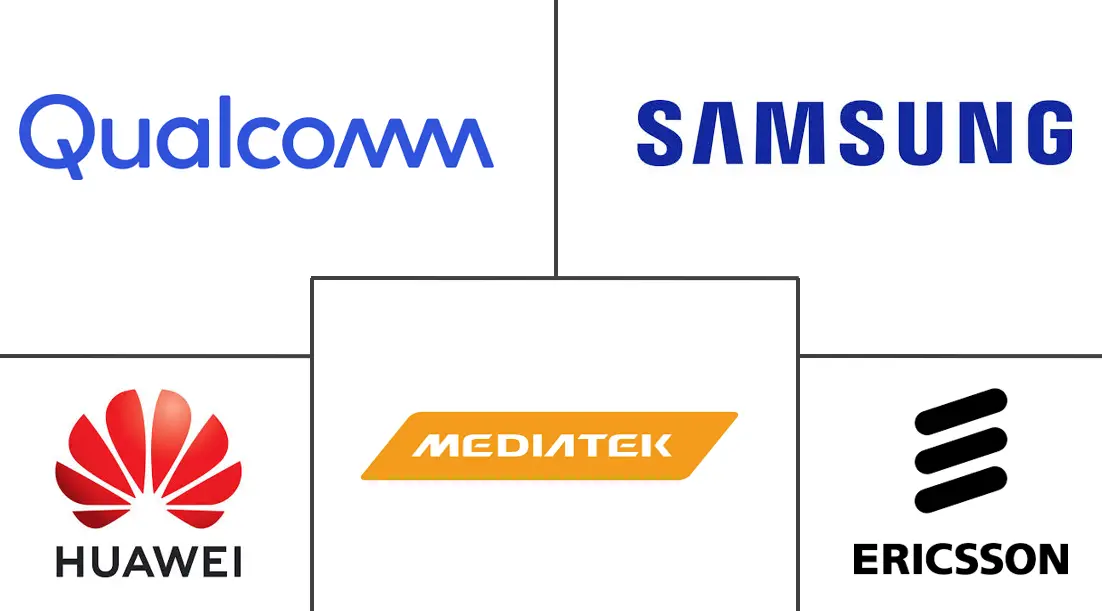5G Chipset Market Size and Share
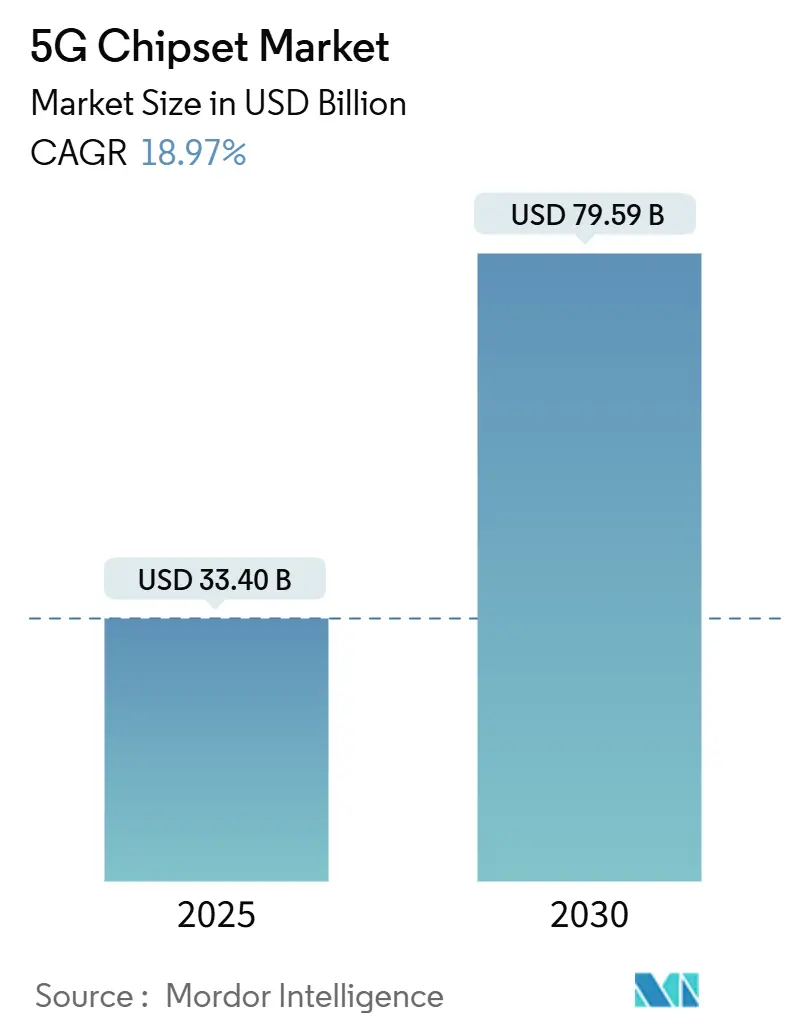
5G Chipset Market Analysis by Mordor Intelligence
The 5G chipset market size stood at USD 33.40 billion in 2025 and is forecast to reach USD 79.59 billion by 2030, advancing at an 18.97% CAGR. Sustained infrastructure spending, growing edge-AI workloads, and intensified private-network adoption continue to fuel demand for specialized silicon. Sub-6 GHz roll-outs keep volumes high, while mmWave and sub-3 nm migrations add value through premium pricing. Government incentives, most notably the USD 52.7 billion CHIPS Act, are boosting domestic fab capacity in the United States. Rising geopolitical risk around export controls and gallium supply underscores the need for dual-sourcing strategies. Against this backdrop, the 5G chipset market is benefiting from tighter vertical integration among device makers and network vendors that seek to secure differentiated IP and supply resilience.
Key Report Takeaways
- By chipset type, ASICs led with 25.8% revenue share of the 5G chipset market in 2024, while FPGAs posted the fastest 20.2% CAGR through 2030.
- By technology node, the 5 nm category held 31.5% of the 5G chipset market share in 2024; however, sub-3 nm is projected to expand at a 20.4% CAGR through 2030.
- By operational frequency, sub-6 GHz accounted for 58.7% of the 5G chipset market size in 2024, whereas frequencies above 39 GHz are set to grow at a 19.7% CAGR over the same period.
- By end-user industry, consumer electronics accounted for 27.9% of the 2024 revenue in the 5G chipset market; industrial automation is projected to advance at a 20.1% CAGR through 2030.
- By geography, Asia-Pacific commanded 47.8% of the 2024 revenue of the 5G chipset market and is on track for a 19.6% CAGR through 2030.
Global 5G Chipset Market Trends and Insights
Drivers Impact Analysis
| Driver | (~) % Impact on CAGR Forecast | Geographic Relevance | Impact Timeline |
|---|---|---|---|
| Surging global 5G RAN roll-outs | +3.2% | Global, with Asia-Pacific leading | Medium term (2-4 years) |
| mmWave spectrum auctions unlocking new silicon demand | +2.8% | North America, Europe, select Asia Pacific markets | Medium term (2-4 years) |
| Edge-AI workloads shifting toward 5 nm and below nodes | +4.1% | Global, concentrated in developed markets | Short term (≤ 2 years) |
| Open RAN disaggregation driving merchant silicon uptake | +2.3% | North America, Europe, India | Medium term (2-4 years) |
| Private-5G adoption across Industry 4.0 facilities | +3.5% | Global, strong growth in manufacturing hubs | Medium term (2-4 years) |
| Government CHIPS-style subsidies for domestic fabs | +2.9% | US, EU, Japan, South Korea, India | Long term (≥ 4 years) |
| Source: Mordor Intelligence | |||
Surging Global 5G RAN Roll-outs Drive Infrastructure Semiconductor Demand
Commercial 5G population coverage is set to reach 80% by 2029, up from 40% in 2024, pushing operators to densify networks and invest in high-capacity backhaul. Small-cell architectures require efficient RF front-end modules optimized for mid-band and mmWave operation, while massive MIMO deployments call for advanced power-management ICs that keep energy budgets in check. Demand spikes are most visible across Asia-Pacific, where China added over 800,000 5G base stations in 2024 alone. These factors sustain a broad revenue base for both digital and analog 5G chipset market participants.
mmWave Spectrum Auctions Unlock Advanced Silicon Opportunities
Aggressive spectrum auctions in the 24–47 GHz bands have attracted more than USD 35 billion in bids since 2024 in the United States, Japan, and South Korea.[1]Reader Forum, “mmWave Takes Centre Stage in 2024,” rcrwireless.com mmWave’s short propagation range mandates advanced beam-forming ICs, high-linearity power amplifiers, and adaptive antenna-tuning chips, each commanding premium gross margins. Fixed-wireless access roll-outs place particular stress on thermal design and yield improvements, rewarding vendors that can offer integrated front-end reference designs with robust calibration software.
Edge-AI Workloads Accelerate Advanced Node Adoption
Smartphones, C-V2X terminals, and factory gateways are embedding neural accelerators that operate at the network edge. Marvell’s proof-of-concept 2 nm IP on TSMC’s N2 process exemplifies the race toward transistor densities above 300 Mtr/mm².[2]Marvell Technology, “Marvell Demonstrates Industry-Leading 2 nm Silicon,” marvell.com As inference moves local, die area allocation shifts from general-purpose cores to matrix multiplication engines, reinforcing the business case for custom ASIC tape-outs. The resulting wafer demand at 2 nm and 3 nm nodes expands the addressable 5G chipset market at the premium end.
Open RAN Disaggregation Transforms Vendor Ecosystem Dynamics
Open RAN’s mix-and-match architecture lowers switching cost for operators and creates space for merchant silicon suppliers that previously struggled to penetrate vertically integrated stacks. Trials by Viettel and DOCOMO show early performance parity with proprietary systems when inline accelerators offload Layer-1 processing. Yet multivendor interoperability testing adds engineering overhead, paving the way for turnkey reference platforms anchored by FPGA-based accelerators and custom network interface cards.
Restraints Impact Analysis
| Restraint | (~) % Impact on CAGR Forecast | Geographic Relevance | Impact Timeline |
|---|---|---|---|
| Geopolitical export controls on advanced nodes | -2.7% | Global, US-China trade | Short term (≤ 2 years) |
| Supply-chain fragility for compound semiconductors | -1.9% | Global, Asia Pacific concentration | Medium term (2-4 years) |
| High cap-ex requirements below 3 nm | -1.4% | Global, leading-edge fabs | Long term (≥ 4 years) |
| Power-efficiency trade-offs in mmWave devices | -1.2% | Developed markets with mmWave | Medium term (2-4 years) |
| Source: Mordor Intelligence | |||
Geopolitical Export Controls Create Strategic Semiconductor Bottlenecks
The U.S. Bureau of Industry and Security has expanded its Entity List to restrict the export of advanced EDA tools, lithography systems, and HBM to select Chinese fabless firms. China’s countermeasure limiting gallium and germanium exports could raise gallium prices by 150% and shave USD 3.4 billion off U.S. GDP. These moves force design houses to requalify nodes, build inventory buffers, and invest in diversified supply routes, trimming near-term profitability across the 5G chipset market.
Supply-Chain Fragility Threatens Compound Semiconductor Availability
Gallium arsenide and gallium nitride wafers are critical for power amplifiers that enable efficient mid-band and mmWave transmission. With 98% of gallium supply originating in China, any export disruption jeopardizes RFIC production lead-times. Limited alternative sources in Germany and Kazakhstan, combined with stringent purity requirements, keep substitution options scarce.
Segment Analysis
By Chipset Type: Integration Leads, Flexibility Accelerates
ASICs captured the largest 25.8% revenue share in 2024 as OEMs pursued power-optimized, application-specific performance. This dominance is evident in radio-unit baseband processors that offload Layer-1 scheduling duties. By contrast, FPGAs are forecast to outpace all peers at a 20.2% CAGR, buoyed by Open RAN pilots that value reconfigurability for evolving 3GPP releases. The 5G chipset market size allocated to ASIC-based baseband units is expected to reach USD 29 billion by 2030. System-on-Chip solutions with integrated modems continue gaining popularity in smartphones, wearables, and C-V2X modules because they shrink PCB footprint and lower bill-of-materials costs.
FPGAs also underpin inline accelerator cards that relieve x86 servers of forward-error correction tasks, thereby improving spectral efficiency in virtualized RAN deployments. RFICs maintain steady volume, delivering wide-band front-end filtering and phase-array beam-forming at both mid-band and mmWave frequencies. Millimeter-wave technology chips, antenna tuners, LNAs, power amplifiers, and power-management ICs round out an ecosystem built around mix-and-match reference designs. Collectively, these categories ensure that the 5G chipset market remains vibrant across both commodity and high-margin niches.
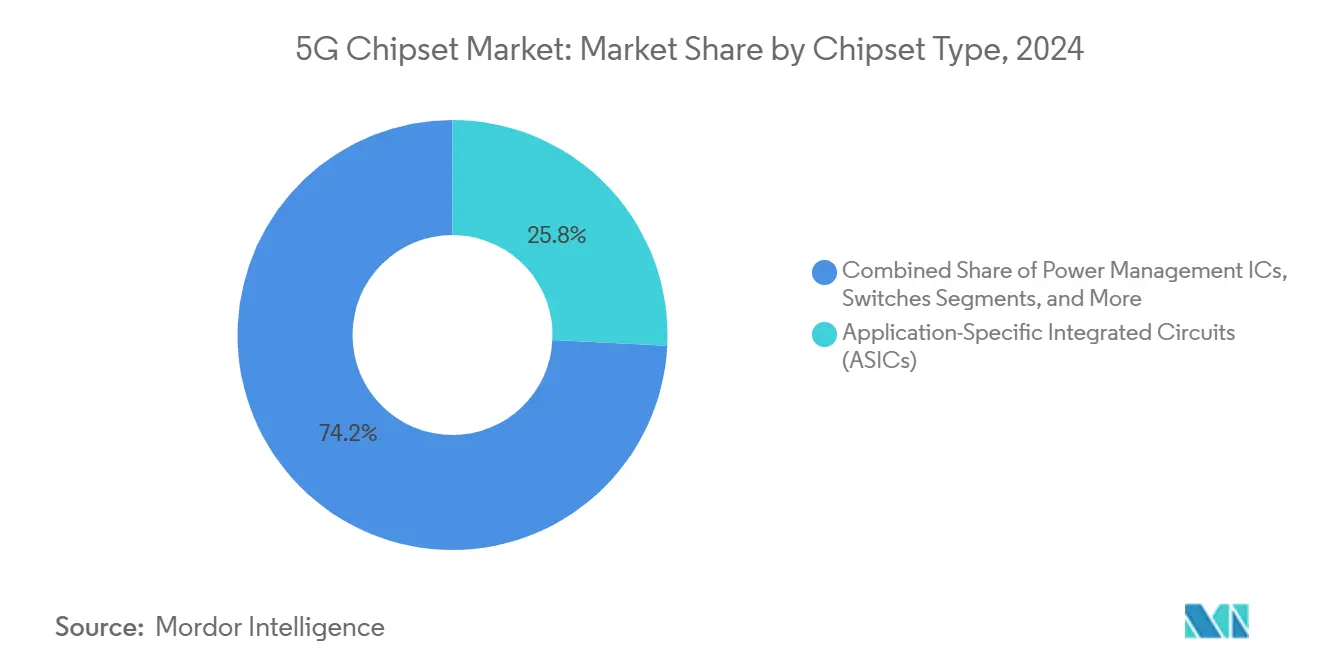
Note: Segment shares of all individual segments available upon report purchase
By Technology Node: 5 nm Dominance Gives Way to Sub-3 nm Innovation
The 5 nm platform accounted for 31.5% of 2024 sales thanks to strong tape-out volume from smartphone modems and cloud accelerator ASICs. Yet sub-3 nm wafers will generate the fastest 20.4% CAGR because edge-AI workloads demand superior performance per watt. The 5G chipset market share for 2 nm chips is projected to climb as TSMC ramps N2 in H2 2025 and Samsung introduces MBCFET gate-all-around architecture. 7 nm remains the node of choice for mid-range handsets, while 16 nm and 28 nm continue serving cost-sensitive IoT gateways and RF switch matrices.
Mature nodes above 28 nm anchor power-management and analog peripherals, where voltage tolerance outweighs density. This balanced node mix cushions supply-demand swings and offers design-for-availability flexibility when geopolitical or natural-disaster shocks disrupt cutting-edge capacity.
By Operational Frequency: Sub-6 GHz Maintains Breadth as mmWave Gains Depth
Sub-6 GHz constituted 58.7% of revenue in 2024, reflecting superior propagation range and the accelerated allocation of 3.3-4.2 GHz spectrum across Asia-Pacific and Europe. Operators lean on this band to meet nationwide coverage requirements at manageable capital intensity. The 5G chipset market size generated by sub-6 GHz RFICs is expected to reach USD 40 billion by 2030. Mid-band frequencies (26–39 GHz) strike a balance between coverage and capacity, supporting both urban macro-cells and enterprise small-cells. Above-39 GHz solutions crucial for massive FWA backhaul are set to expand at a 19.7% CAGR. The WRC-23 decision to study 7.125-8.4 GHz and 14.8-15.35 GHz widens the future design roadmap.[3]Qualcomm Incorporated, “A Leap Toward 6G: Spectrum Allocation,” qualcomm.com
High-band deployments necessitate elaborate phased-array calibration, elevated transistor fMAX, and low-loss interposer packaging. Vendors able to co-optimize these elements will accrue disproportionate market share as spectrum refarming gains momentum.
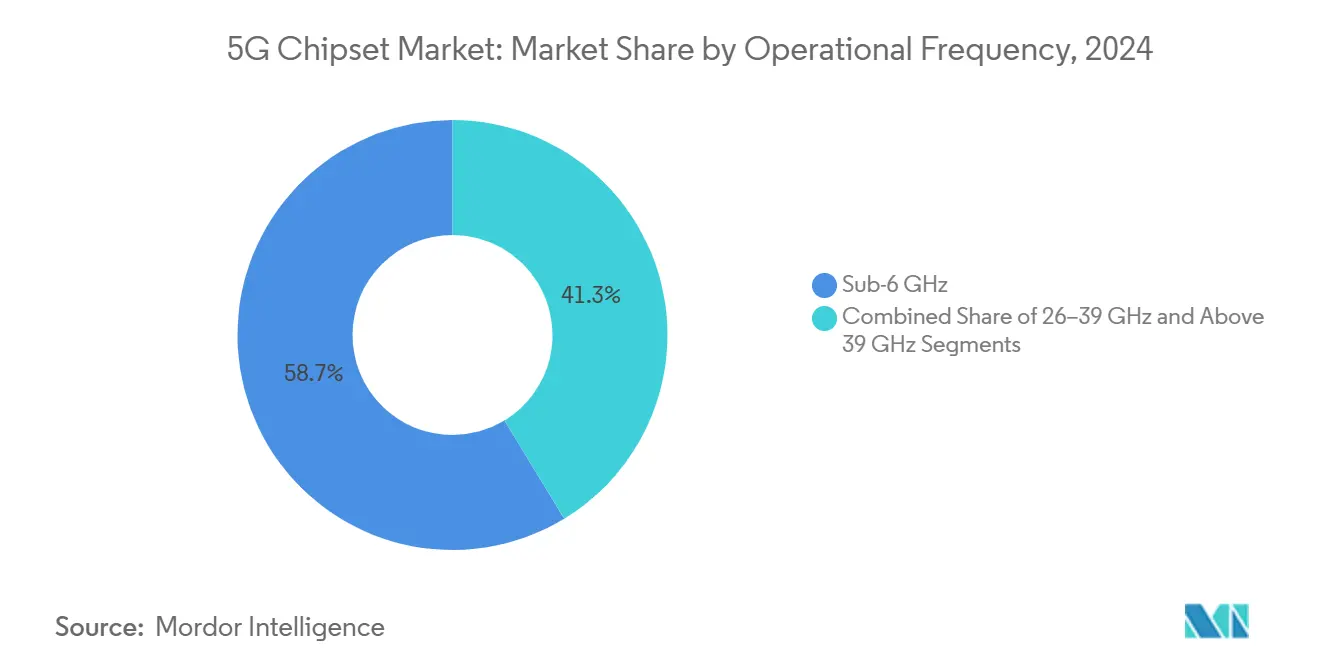
Note: Segment shares of all individual segments available upon report purchase
By End-User Industry: Consumer Electronics Lead While Industrial Automation Surges
Consumer electronics captured 27.9% of 2024 revenue, fueled by premium smartphones, XR headsets, and ultra-HD streaming devices. However, industrial automation outpaces all peers with a 20.1% CAGR as manufacturers deploy private networks for deterministic control loops. The 5G chipset market size assigned to factory automation chips is forecast to exceed USD 9 billion by 2030. IT and telecom infrastructure segments form a resilient baseline because operators refresh radio units on a three- to five-year cadence. Automotive and transportation embrace 5G for autonomous driving scenarios, prompting demand for low-latency V2X chipsets. Healthcare, energy, utilities, and retail follow closely, driven by digital-twin, smart-grid, and immersive-commerce use cases.
Cross-industry synergies emerge as chip vendors repurpose AI accelerators originally designed for smartphones to power mobile robots and warehouse AGVs, improving economies of scale.
Geography Analysis
Asia-Pacific held 47.8% of global revenue in 2024 and is projected to grow at a 19.6% CAGR through 2030. China alone installed more than 1.8 million 5G base stations by mid-2025 despite export-control pressure, securing local demand for RF front-ends and baseband ASICs. South Korea and Japan emphasize mmWave densification, encouraging higher-margin chipset bill-of-materials. India’s PLI scheme supports emerging fab projects targeting 28 nm power-management and RF switch nodes, broadening regional supply diversity.
North America benefits from the CHIPS Act’s infusion and early mmWave adoption. The United States accounts for over 80% of global mmWave device shipments and drives demand for beam-forming ICs. Canada focuses on rural fixed-wireless initiatives that favor sub-6 GHz C-band front-ends. Europe lags in standalone-core adoption; only 2% of sites had full SA functionality by 2025, compared with 24% in the United States. Nordic operators, however, maintain near-complete coverage, driving localized silicon content for energy-efficient macro-cells suited to cold climates.
The Middle East and Africa experience stepped growth, with Gulf Cooperation Council nations building large-scale IoT corridors. South America sees uneven progress as Brazil pushes forward while Argentina grapples with macroeconomic constraints. Overall, regional policy support and spectrum allocation pace remain leading determinants of 5G chipset market momentum.
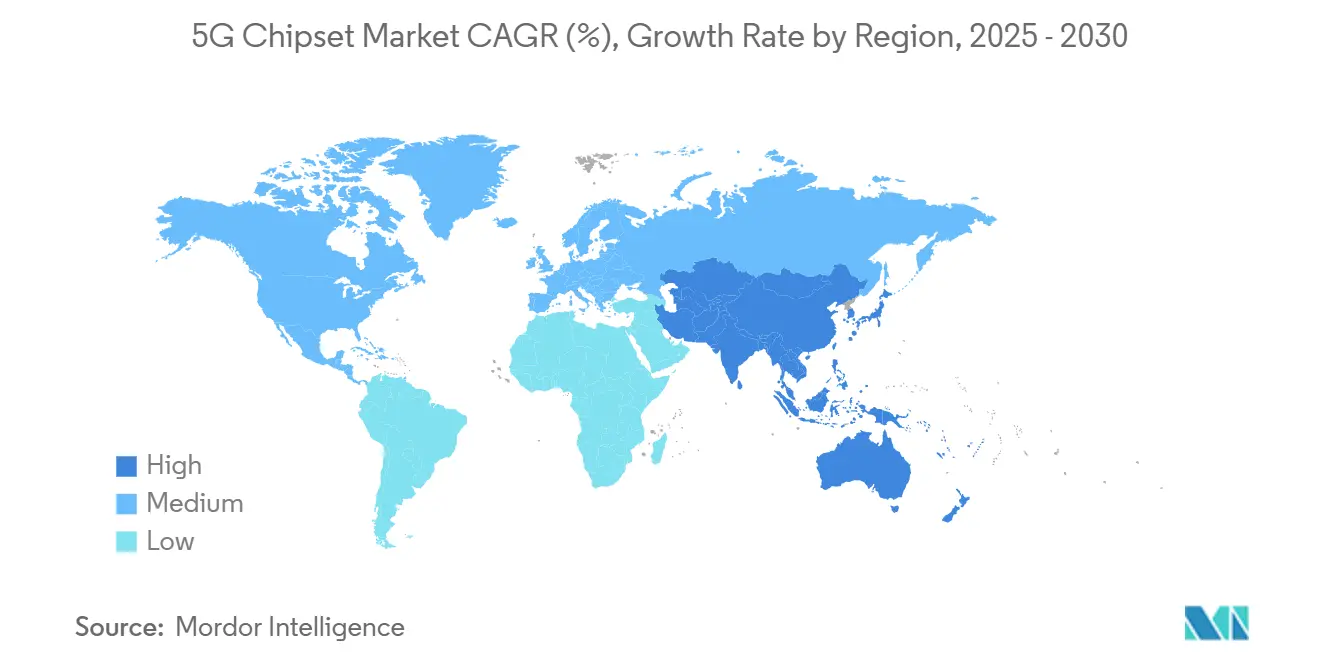
Competitive Landscape
The 5G chipset market exhibits moderate concentration, with the top five vendors controlling a significant share of 2024 revenue. Qualcomm leads in premium smartphone modems, MediaTek dominates mid-range handsets, and Samsung LSI advances vertical integration through Exynos platforms. Intel and Marvell target cloud RAN accelerators, while Broadcom leverages merchant switch ASICs for transport layers.
Strategic moves shape competitive dynamics. Samsung is reportedly exploring a USD 10 billion acquisition of Nokia’s mobile network business to deepen infrastructure reach. HPE finalized its USD 14 billion purchase of Juniper, signaling further convergence between compute and networking silicon. STMicroelectronics partnered with Qualcomm to extend STM32 MCUs into IoT gateways, linking 5G connectivity with edge compute.[4]Nasdaq, “STMicroelectronics and Qualcomm Enter Strategic Collaboration,” nasdaq.com
Investment intensity centers on AI co-processors, advanced packaging, and wide-bandgap materials. MediaTek’s Dimensity 9400+ integrates an all-big-core CPU cluster and Wi-Fi 7 for unified 5G-Wi-Fi handover. Marvell’s 2 nm IP positions it for hyperscale switch silicon orders. onsemi’s acquisition of Qorvo’s SiC JFET line expands its EliteSiC portfolio for data-center power delivery.
Licensing and patent portfolios remain critical. Ericsson’s expansion of ASIC R&D in Bengaluru underpins its goal to ship custom baseband silicon to both internal and third-party radio units. As vertical integration deepens, fabless–foundry relationships tighten, heightening the importance of long-term supply agreements and process co-development.
5G Chipset Industry Leaders
-
Qualcomm Incorporated
-
MediaTek Inc.
-
Samsung Electronics Co., Ltd.
-
Huawei Technologies Co., Ltd.
-
Telefonaktiebolaget LM Ericsson
- *Disclaimer: Major Players sorted in no particular order
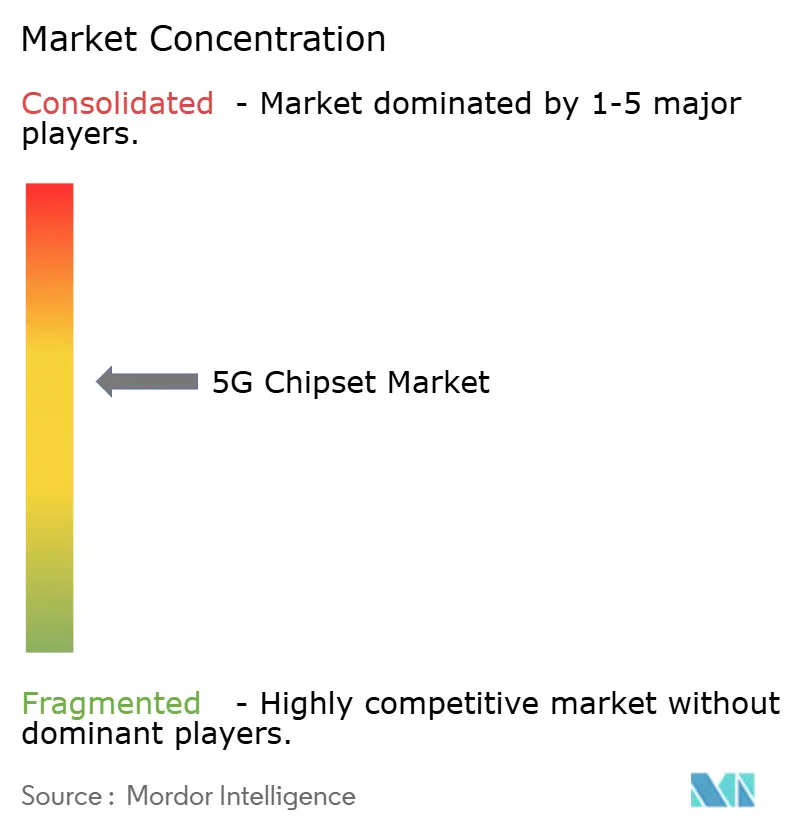
Recent Industry Developments
- August 2025: Samsung Electronics posted Q2 2025 revenue of KRW 74.6 trillion (USD 51 billion), citing robust HBM3E demand and high-density DDR5 momentum.
- July 2025: HPE closed its USD 14 billion acquisition of Juniper Networks, enhancing its AI-driven networking reach.
- May 2025: MediaTek recorded Q1 2025 revenue of NT$153.3 billion (USD 4.90 billion), up 14.9% YoY on 5G modem strength.
- March 2025: Qualcomm unveiled the X85 5G Modem-RF with 12.5 Gbps peak download and an integrated AI engine.
- February 2025: MediaTek introduced the M90 5G-Advanced modem featuring MMAI power optimization.
- January 2025: onsemi completed its USD 115 million acquisition of Qorvo’s SiC JFET unit to widen the EliteSiC scope.
Global 5G Chipset Market Report Scope
5G chipsets enable 5G packet transmission on smartphones, portable hotspots, IoT devices, and, increasingly, notebook PCs with mobile network capabilities. 5G mobile devices will combine familiar sub-6GHz bands with new MIMO antenna systems and high-frequency millimeter-wave (mmWave) bands with highly focused beam-steering.
The 5G Chipset Market Report is Segmented by Chipset Type (Application-Specific Integrated Circuits, System-On-Chip With Integrated Modem, Radio-Frequency Integrated Circuits, Millimeter-Wave Technology Chips, Field-Programmable Gate Arrays, Power Management ICs, Antenna Tuner ICs, Switches, LNAs and Power Amplifiers, and Others), Technology Node (<3nm, 3nm, 5nm, 7nm, 16nm, 28nm, and > 28 nm), Operational Frequency (Sub-6 GHz, 26–39 GHz, and Above 39 GHz), End-User Industry (IT, Telecom and Network Infrastructure, Consumer Electronics (incl. Smart Home), Industrial Automation, Automotive and Transportation, Energy and Utility, Healthcare, Retail, and Other End-User Industries), and Geography (North America, Europe, Asia Pacific, South America, and Middle East and Africa). The Market Forecasts are Provided in Terms of Value (USD).
| Application-Specific Integrated Circuits (ASICs) |
| System-on-Chip with Integrated Modem (SoC) |
| Radio-Frequency Integrated Circuits (RFICs) |
| Millimeter-Wave Technology Chips |
| Field-Programmable Gate Arrays (FPGAs) |
| Power Management ICs |
| Antenna Tuner ICs |
| Switches |
| LNAs and Power Amplifiers |
| Others (Filters, Discrete Memory, Converters, etc.) |
| < 3 nm |
| 3 nm |
| 5 nm |
| 7 nm |
| 16 nm |
| 28 nm |
| > 28 nm |
| Sub-6 GHz |
| 26-39 GHz |
| Above 39 GHz |
| IT, Telecom and Network Infrastructure |
| Consumer Electronics (incl. Smart Home) |
| Industrial Automation |
| Automotive and Transportation |
| Energy and Utilities |
| Healthcare |
| Retail |
| Other End-User Industries |
| North America | United States | |
| Canada | ||
| Mexico | ||
| South America | Brazil | |
| Argentina | ||
| Rest of South America | ||
| Europe | Germany | |
| United Kingdom | ||
| France | ||
| Italy | ||
| Spain | ||
| Rest of Europe | ||
| Asia-Pacific | China | |
| Japan | ||
| South Korea | ||
| India | ||
| Singapore | ||
| Australia | ||
| Rest of Asia-Pacific | ||
| Middle East and Africa | Middle East | Saudi Arabia |
| United Arab Emirates | ||
| Turkey | ||
| Rest of Middle East | ||
| Africa | South Africa | |
| Nigeria | ||
| Egypt | ||
| Rest of Africa | ||
| By Chipset Type | Application-Specific Integrated Circuits (ASICs) | ||
| System-on-Chip with Integrated Modem (SoC) | |||
| Radio-Frequency Integrated Circuits (RFICs) | |||
| Millimeter-Wave Technology Chips | |||
| Field-Programmable Gate Arrays (FPGAs) | |||
| Power Management ICs | |||
| Antenna Tuner ICs | |||
| Switches | |||
| LNAs and Power Amplifiers | |||
| Others (Filters, Discrete Memory, Converters, etc.) | |||
| By Technology Node | < 3 nm | ||
| 3 nm | |||
| 5 nm | |||
| 7 nm | |||
| 16 nm | |||
| 28 nm | |||
| > 28 nm | |||
| By Operational Frequency | Sub-6 GHz | ||
| 26-39 GHz | |||
| Above 39 GHz | |||
| By End-User Industry | IT, Telecom and Network Infrastructure | ||
| Consumer Electronics (incl. Smart Home) | |||
| Industrial Automation | |||
| Automotive and Transportation | |||
| Energy and Utilities | |||
| Healthcare | |||
| Retail | |||
| Other End-User Industries | |||
| By Geography | North America | United States | |
| Canada | |||
| Mexico | |||
| South America | Brazil | ||
| Argentina | |||
| Rest of South America | |||
| Europe | Germany | ||
| United Kingdom | |||
| France | |||
| Italy | |||
| Spain | |||
| Rest of Europe | |||
| Asia-Pacific | China | ||
| Japan | |||
| South Korea | |||
| India | |||
| Singapore | |||
| Australia | |||
| Rest of Asia-Pacific | |||
| Middle East and Africa | Middle East | Saudi Arabia | |
| United Arab Emirates | |||
| Turkey | |||
| Rest of Middle East | |||
| Africa | South Africa | ||
| Nigeria | |||
| Egypt | |||
| Rest of Africa | |||
Key Questions Answered in the Report
How large is the 5G chipset market in 2025?
The 5G chipset market size reached USD 33.40 billion in 2025 and is set to hit USD 79.59 billion by 2030.
Which chipset category leads revenue today?
ASICs lead with a 25.8% share because their fixed-function design maximizes performance per watt in radios and smartphones.
What is the fastest-growing segment by technology node?
Sub-3 nm processes are expanding at a 20.4% CAGR as edge-AI devices demand higher transistor densities.
Why is Asia-Pacific dominant in 5G chipsets?
Aggressive network roll-outs in China, South Korea, Japan, and India generate nearly half of global chipset demand.
How are export controls affecting supply chains?
Restrictions on advanced tools and gallium export raise compliance costs and encourage multi-source strategies.
Which end-user industry shows the highest growth?
Industrial automation is growing fastest at 20.1% CAGR as factories deploy private 5G networks for real-time control.
Page last updated on:
